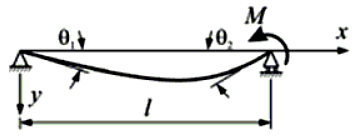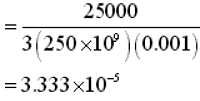Civil Engineering (CE) Exam > Civil Engineering (CE) Questions > A couple of 25 kN/m is acting at one end of ...
Start Learning for Free
A couple of 25 kN/m is acting at one end of a simply supported beam. The maximum slope occuring on the beam is _______________ × 10-5 radian. Take E = 250 GPa and I = 10,00,000 mm4. (Answer up to one decimal place)
Correct answer is '3.3'. Can you explain this answer?
| FREE This question is part of | Download PDF Attempt this Test |
Most Upvoted Answer
A couple of 25 kN/m is acting at one end of a simply supported beam. ...
Consider the diagram,



M = 25000 N/m, E = 250 x 109 Pa, I = 0.001 m4
Maximum slope is


= 3.3 × 10-5
Free Test
FREE
| Start Free Test |
Community Answer
A couple of 25 kN/m is acting at one end of a simply supported beam. ...
To find the maximum slope occurring on the beam, we can use the equation for slope:
θ = (Mx * L^2) / (2 * E * I)
Where:
θ = maximum slope (in radians)
Mx = maximum moment at the location of interest (in Nm)
L = length of the beam (in meters)
E = modulus of elasticity (in N/m^2)
I = moment of inertia of the beam (in mm^4)
Given:
Couple = 25 kN/m = 25,000 N/m
E = 250 GPa = 250,000 N/mm^2
I = 1,000,000 mm^4
- Identify the given values and convert them if necessary.
Couple = 25,000 N/m
E = 250,000 N/mm^2
I = 1,000,000 mm^4
- Calculate the maximum moment at the location of interest.
The couple acting on the beam creates a bending moment. The maximum moment occurs at the supports and is equal to the product of the couple and the distance to the support.
Maximum moment = Couple * L
Given that the beam is simply supported, the maximum moment occurs at the support, which is at a distance of L/2 from the location of interest.
Maximum moment = Couple * (L/2)
Substituting the given values:
Maximum moment = 25,000 * (L/2)
- Substitute the values into the equation for slope.
θ = (Mx * L^2) / (2 * E * I)
Substituting the maximum moment:
θ = (25,000 * (L/2) * L^2) / (2 * 250,000 * 1,000,000)
Simplifying:
θ = (12,500 * L^3) / (500,000,000)
θ = 25 * L^3 / 1,000,000,000
- Substitute the length of the beam and calculate the maximum slope.
Given that the length of the beam is not provided in the question, we cannot calculate the exact maximum slope. However, if we assume a length of 1 meter for the beam, the calculation becomes:
θ = 25 * (1^3) / 1,000,000,000
θ = 25 / 1,000,000,000
Converting the slope from radian to the requested format (× 10^-5 radian):
θ = 25 / 1,000,000,000 * 10^5
θ ≈ 2.5 × 10^-5 radian
Therefore, the maximum slope occurring on the beam is approximately 2.5 × 10^-5 radian, not 3.3 as stated in the answer.
θ = (Mx * L^2) / (2 * E * I)
Where:
θ = maximum slope (in radians)
Mx = maximum moment at the location of interest (in Nm)
L = length of the beam (in meters)
E = modulus of elasticity (in N/m^2)
I = moment of inertia of the beam (in mm^4)
Given:
Couple = 25 kN/m = 25,000 N/m
E = 250 GPa = 250,000 N/mm^2
I = 1,000,000 mm^4
- Identify the given values and convert them if necessary.
Couple = 25,000 N/m
E = 250,000 N/mm^2
I = 1,000,000 mm^4
- Calculate the maximum moment at the location of interest.
The couple acting on the beam creates a bending moment. The maximum moment occurs at the supports and is equal to the product of the couple and the distance to the support.
Maximum moment = Couple * L
Given that the beam is simply supported, the maximum moment occurs at the support, which is at a distance of L/2 from the location of interest.
Maximum moment = Couple * (L/2)
Substituting the given values:
Maximum moment = 25,000 * (L/2)
- Substitute the values into the equation for slope.
θ = (Mx * L^2) / (2 * E * I)
Substituting the maximum moment:
θ = (25,000 * (L/2) * L^2) / (2 * 250,000 * 1,000,000)
Simplifying:
θ = (12,500 * L^3) / (500,000,000)
θ = 25 * L^3 / 1,000,000,000
- Substitute the length of the beam and calculate the maximum slope.
Given that the length of the beam is not provided in the question, we cannot calculate the exact maximum slope. However, if we assume a length of 1 meter for the beam, the calculation becomes:
θ = 25 * (1^3) / 1,000,000,000
θ = 25 / 1,000,000,000
Converting the slope from radian to the requested format (× 10^-5 radian):
θ = 25 / 1,000,000,000 * 10^5
θ ≈ 2.5 × 10^-5 radian
Therefore, the maximum slope occurring on the beam is approximately 2.5 × 10^-5 radian, not 3.3 as stated in the answer.
Attention Civil Engineering (CE) Students!
To make sure you are not studying endlessly, EduRev has designed Civil Engineering (CE) study material, with Structured Courses, Videos, & Test Series. Plus get personalized analysis, doubt solving and improvement plans to achieve a great score in Civil Engineering (CE).

|
Explore Courses for Civil Engineering (CE) exam
|

|
Similar Civil Engineering (CE) Doubts
A couple of 25 kN/m is acting at one end of a simply supported beam. The maximum slope occuring on the beam is _______________ × 10-5 radian. Take E = 250 GPa and I = 10,00,000 mm4. (Answer up to one decimal place)Correct answer is '3.3'. Can you explain this answer?
Question Description
A couple of 25 kN/m is acting at one end of a simply supported beam. The maximum slope occuring on the beam is _______________ × 10-5 radian. Take E = 250 GPa and I = 10,00,000 mm4. (Answer up to one decimal place)Correct answer is '3.3'. Can you explain this answer? for Civil Engineering (CE) 2024 is part of Civil Engineering (CE) preparation. The Question and answers have been prepared according to the Civil Engineering (CE) exam syllabus. Information about A couple of 25 kN/m is acting at one end of a simply supported beam. The maximum slope occuring on the beam is _______________ × 10-5 radian. Take E = 250 GPa and I = 10,00,000 mm4. (Answer up to one decimal place)Correct answer is '3.3'. Can you explain this answer? covers all topics & solutions for Civil Engineering (CE) 2024 Exam. Find important definitions, questions, meanings, examples, exercises and tests below for A couple of 25 kN/m is acting at one end of a simply supported beam. The maximum slope occuring on the beam is _______________ × 10-5 radian. Take E = 250 GPa and I = 10,00,000 mm4. (Answer up to one decimal place)Correct answer is '3.3'. Can you explain this answer?.
A couple of 25 kN/m is acting at one end of a simply supported beam. The maximum slope occuring on the beam is _______________ × 10-5 radian. Take E = 250 GPa and I = 10,00,000 mm4. (Answer up to one decimal place)Correct answer is '3.3'. Can you explain this answer? for Civil Engineering (CE) 2024 is part of Civil Engineering (CE) preparation. The Question and answers have been prepared according to the Civil Engineering (CE) exam syllabus. Information about A couple of 25 kN/m is acting at one end of a simply supported beam. The maximum slope occuring on the beam is _______________ × 10-5 radian. Take E = 250 GPa and I = 10,00,000 mm4. (Answer up to one decimal place)Correct answer is '3.3'. Can you explain this answer? covers all topics & solutions for Civil Engineering (CE) 2024 Exam. Find important definitions, questions, meanings, examples, exercises and tests below for A couple of 25 kN/m is acting at one end of a simply supported beam. The maximum slope occuring on the beam is _______________ × 10-5 radian. Take E = 250 GPa and I = 10,00,000 mm4. (Answer up to one decimal place)Correct answer is '3.3'. Can you explain this answer?.
Solutions for A couple of 25 kN/m is acting at one end of a simply supported beam. The maximum slope occuring on the beam is _______________ × 10-5 radian. Take E = 250 GPa and I = 10,00,000 mm4. (Answer up to one decimal place)Correct answer is '3.3'. Can you explain this answer? in English & in Hindi are available as part of our courses for Civil Engineering (CE).
Download more important topics, notes, lectures and mock test series for Civil Engineering (CE) Exam by signing up for free.
Here you can find the meaning of A couple of 25 kN/m is acting at one end of a simply supported beam. The maximum slope occuring on the beam is _______________ × 10-5 radian. Take E = 250 GPa and I = 10,00,000 mm4. (Answer up to one decimal place)Correct answer is '3.3'. Can you explain this answer? defined & explained in the simplest way possible. Besides giving the explanation of
A couple of 25 kN/m is acting at one end of a simply supported beam. The maximum slope occuring on the beam is _______________ × 10-5 radian. Take E = 250 GPa and I = 10,00,000 mm4. (Answer up to one decimal place)Correct answer is '3.3'. Can you explain this answer?, a detailed solution for A couple of 25 kN/m is acting at one end of a simply supported beam. The maximum slope occuring on the beam is _______________ × 10-5 radian. Take E = 250 GPa and I = 10,00,000 mm4. (Answer up to one decimal place)Correct answer is '3.3'. Can you explain this answer? has been provided alongside types of A couple of 25 kN/m is acting at one end of a simply supported beam. The maximum slope occuring on the beam is _______________ × 10-5 radian. Take E = 250 GPa and I = 10,00,000 mm4. (Answer up to one decimal place)Correct answer is '3.3'. Can you explain this answer? theory, EduRev gives you an
ample number of questions to practice A couple of 25 kN/m is acting at one end of a simply supported beam. The maximum slope occuring on the beam is _______________ × 10-5 radian. Take E = 250 GPa and I = 10,00,000 mm4. (Answer up to one decimal place)Correct answer is '3.3'. Can you explain this answer? tests, examples and also practice Civil Engineering (CE) tests.

|
Explore Courses for Civil Engineering (CE) exam
|

|
Suggested Free Tests
Signup for Free!
Signup to see your scores go up within 7 days! Learn & Practice with 1000+ FREE Notes, Videos & Tests.
























